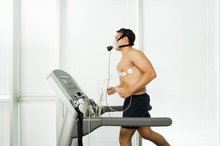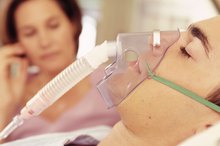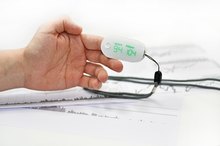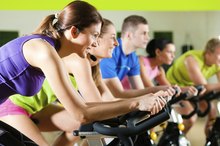Pulse Oximeter for Workouts
Typically found in hospital rooms and rehabilitation facilities, pulse oximeters are also slowly cropping up in fitness centers and gyms 4. Used to measure the amount of oxygenated blood in the body, pulse oximeters are simple noninvasive devices 34. Although measuring oxygen saturation during a workout may not be necessary for most people, wearing a pulse oximeter for workouts can be quite beneficial in certain situations 2.
Identification
A pulse oximeter is a small electronic device that measures the amount of oxygen carried in your blood 2. The device clips onto the end of your index finger and radiates invisible infrared light and visible red light into the finger. Oxygenated blood and deoxygenated blood there absorb different amounts of these lights. By calculating the difference between these two, the pulse oximeter measures how much oxygen is in your blood 2. The pulse oximeter is commonly used in hospitals to determine how effectively your heart, lungs and circulatory system work together 2.
Oxygen Saturation
How to Calculate VO2 Reserve
Learn More
The pulse oximeter measures oxygen saturation, or the exact percentage of hemoglobin that is currently saturated with oxygen 2. Healthy individuals typically have an oxygen saturation of 97 to 99 percent. However, an oxygen saturation of greater than 92 percent is generally considered safe and normal. Measuring oxygen saturation may be important for patients with chronic respiratory conditions, such as asthma. If the medical condition interferes with the amount of oxygen taken into the body, a pulse oximeter can monitor a patient's oxygen levels to ensure safety 2.
Benefits During Exercise
Serious athletes may wear a pulse oximeter during exercise simply to monitor their oxygen levels during strenuous workouts 2. You may also wish to wear a pulse oximeter while exercising in a high-altitude area, such as in the mountains 2. To ensure adequate oxygenation, people with respiratory conditions and patients recovering from a recent illness or surgery might also want to wear a pulse oximeter during exercise 2. If you have questions about whether you should wear a pulse oximeter during exercise, speak with a medical professional 2. Your doctor can make an appropriate judgment and recommendation based on your past and current health status.
Considerations
Disadvantages of Pulse Oximetry
Learn More
If your hands become sweaty while exercising, the pulse oximeter may slip off your finger 2. Additionally, people with unusually small or large fingers may also have a difficult time keeping the device on the finger. If necessary, wrap a small amount of medical tape around the device and finger to keep it securely in place. If your workout requires extensive use of your hands, such as during basketball or weightlifting, attach the pulse oximeter to your earlobe 2. Again, a small amount of tape may be necessary to hold it in place.
Fun Fact
In 2010, researchers at Mercyhurst College in Pennsylvania used pulse oximeters in a study on wheatgrass juice and exercise 34. The study was designed to determine whether the ingestion of wheatgrass juice improved blood oxygen saturation during exercise 6. Approxiately 20 minutes after ingesting wheatgrass juice, participants ran for 20 minutes on a treadmill while wearing a pulse oximeter 2. The study concluded that ingesting wheatgrass before exercise did, in fact, improve blood oxygenation during exercise 6.
Related Articles
References
- American Association Of Critical-Care Nurses: Oxygen Saturation Monitoring by Pulse Oximetry
- Boston Globe: What Is A Pulse Oximeter and What Does It Measure?
- The Internet Journal Of Alternative Medicine: Monitoring the Oxygenation of Blood During Exercise After Ingesting Wheatgrass Juice
- Lipnick MS, Feiner JR, Au P, Bernstein M, Bickler PE. The Accuracy of 6 Inexpensive Pulse Oximeters Not Cleared by the Food and Drug Administration: The Possible Global Public Health Implications. Anesth Analg. 2016;123(2):338-45.
- Hakverdioğlu yönt G, Akin korhan E, Dizer B. The effect of nail polish on pulse oximetry readings. Intensive Crit Care Nurs. 2014;30(2):111-5. doi:10.1016/j.iccn.2013.08.003
Writer Bio
Krista Sheehan is a registered nurse and professional writer. She works in a neonatal intensive care unit (NICU) and her previous nursing experience includes geriatrics, pulmonary disorders and home health care. Her professional writing works focus mainly on the subjects of physical health, fitness, nutrition and positive lifestyle changes.









